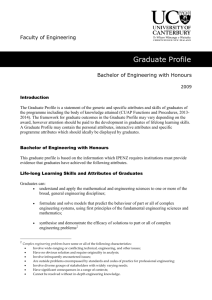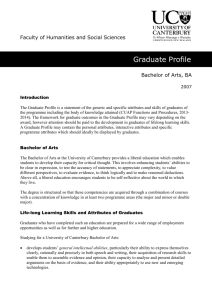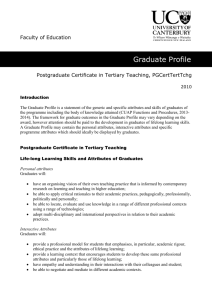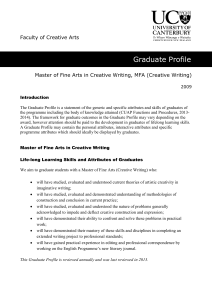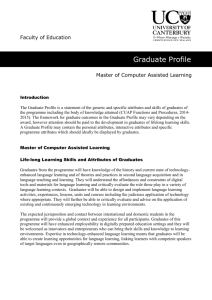Over-education - University of Kent
advertisement
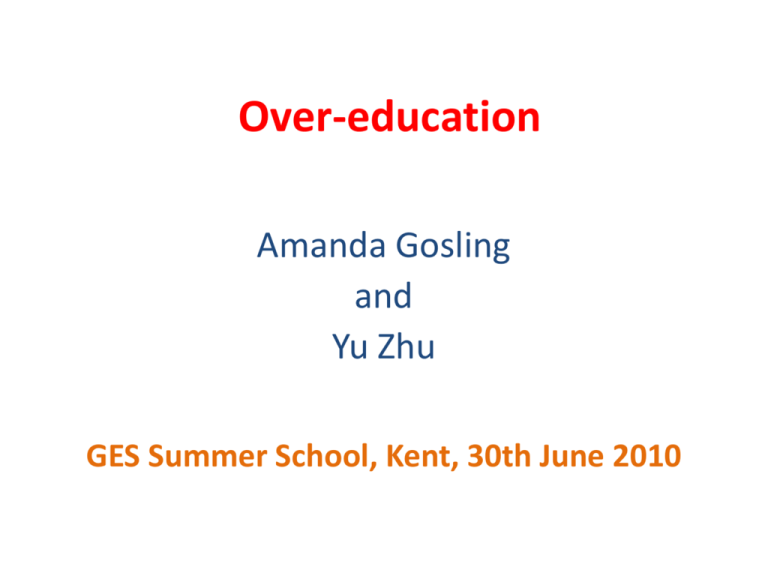
Over-education Amanda Gosling and Yu Zhu GES Summer School, Kent, 30th June 2010 Structure • • • • Introduction and Motivation Background (literature, some trends and data A bit of theory Estimating the extent of over-education and discussion of some evidence • Tea Break • Discussion Why look at over-education? • Over-education is a very active research field: – Google Scholar keyword search returns 2000+ papers in Business, Administration, Finance, and Economics; and another 12000+ papers in Social Sciences, Arts and Humanities • Policy – Controversy over 50% target of cohort in further or higher education – Debate over the level and mechanisms for funding and subsidy – Current (25% help!) funding cuts • Skills and Concepts – Controversy over over-education is a good way to understand what labour economics are concerned about, the models and concepts used and the key areas of disagreement • Right way to model the labour market • How to estimate the return to education? • How to think about policy interventions • Workshop should not be considered a summary of everything there is to know about over-education but an illustration of current thinking about labour markets through this particular question Definitions • Micro – Over-education refers to the situation when a job-holder has an achieved qualification above that which would currently be required for someone to get the job (rather than to do the job). – As such, it represents graduate labour market disequilibrium: workers possess excess educational qualifications relative to those their jobs require. • Macro – Labour market has “too many” graduates – Credentialism – Again represent disequilibrium • Examples – – – – – – – Slacker Philosophy PhD SAHM Mother with small children unable to find suitable jobs with flexible/part time hours Russian Labour market Early labour market experiences Long run graduates “trapped” in low status jobs Background • Emphasis on education expansion – Third way (emphasis on equality of ops. rather than of outcomes) – Becoming more controversial • Academic – – – – Freeman (the over-educated American) Research on demand and supply of skills Research on large (and growing) returns to education Micro led research on over-education (and its criticisms) • Factual – Changes in “return” to education – Participation in education – Long series on education by occupation and gender Academic background (1) Cobwebmodel Graduate wage supply Wage associated with zero rents demand Graduate employment Card and Lemieux (QJE 2001) • Look at changes over time in relative wage of graduates – Hypothesis that part of the changes can be explain by changes in relative supply – Idea that demand and supply are always racing to keep up with each other • Strong support using US micro data • BUT – Identification problems – Identification relies on non-substitutability of workers of different ages – Estimate is “raw” What do we know about the return to education? • Early work (e.g. Dennison 1962, 1967) on growth accounting – But is education a consumption or investment good? • Mincer, Becker Human Capital Wage regressions – Rate of return (like on any other asset) – High but fluctuating – Sheepskin effects • Later (Ashenfelter, Angrist, Kruegar, Walker) on solving the “ability bias” problem – Use of instrumental variables to relate differences in wages to differences in education that are not a result of differences in ability (e.g. Twin studies, Vietnam draft, Compulsory School Leaving laws) – Measured returns appear to RISE • Measurement error • Heterogeneity in Returns (marginal entrant different from the average, suggestion of credit constraints) What do we know about the return to education? • Changes in the return to education over time (Card, Gosling et al. Schmitt). – Sharp rise over 80s and early 90s – Evidence (Green and Zhu) that return to education for younger cohorts has flattened or even fallen • Growing focus on the distribution of returns using techniques like quantile regressions – Starts off with Buschinsky (1996) – Key difficulty is that the distribution of returns is NOT the same as the distribution of differences – Treatment effect literature • Consensus that all changes to the structure of wages cannot be explained by differences in the demand and supply of education and skills Over–education literature • • • • • • • Consequences (wages, job satisfaction Causes (race, gender, discrimination, ability) Measurement Changes over time Long versus short run Implications for human capital model Is this a meaningful avenue for research? Now some data on background trends Own calculations using FES and BHPS data with university degree stayed on at school past 18 with any degree Proportion of 25-30 year olds .35 .3 .25 .2 .15 1978 1982 1986 1990 Supply of Education (Men) 1994 year 1998 2002 2006 with university degree stayed on at school past 18 with any degree Proportion of 25-30 year olds .4 .35 .3 .25 .2 .15 1978 1982 1986 1990 Supply of Education (Women) 1994 year 1998 2002 2006 Degree versus no qual Post 18 versus compulsory Differences in wages controlling for age .7 .65 .6 .55 .5 .45 .4 1978 1982 1986 1990 1994 year Men 1998 2002 2006 Degree versus no qual Post 18 versus compulsory Differences in wages controlling for age .85 .8 .75 .7 .65 .6 .55 1978 1982 1986 1990 1994 year Women 1998 2002 2006 Differences in employment rates controlling for age Degree versus no qual Post 18 versus compulsory 1.4 1.3 1.2 1.1 1 1978 1982 1986 1990 1994 year men 1998 2002 2006 Differences in employment rates controlling for age Degree versus no qual Post 18 versus compulsory 1.8 1.6 1.4 1.2 1 1978 1982 1986 1990 women 1994 year 1998 2002 2006 bhps fes Men graduate jobs Men non graduate jobs .4 .08 .35 .06 .3 .04 .25 .02 1978 1984 1990 1996 2002 2008 1978 Women graduate jobs 1984 1990 1996 2002 2008 2002 2008 Women non graduate jobs .1 .4 .08 .06 .35 .04 .3 .02 1978 1984 1990 1996 2002 2008 1978 1984 1990 1996 year Proportions of Workers with Higher Ed 10th percentile FES 90th percentile FES 10th percentile BHPS 90th percentile BHPS .8 .6 .4 .2 1978 1982 1986 1990 1994 year 1998 Quantile estimates of Ed diff (Men) 2002 2006 10th percentile FES 90th percentile FES 10th percentile BHPS 90th percentile BHPS 1 .8 .6 .4 .2 1978 1982 1986 1990 1994 year 1998 2002 Quantile estimates of Ed diff (Women) 2006 Summary • Dramatic increase in relative supply of educated workers over last 30 years • Some weak evidence that the return has declined – For younger cohorts – Distribution of returns • Picture becomes less clear cut when we look at employment • More graduates doing non-graduate jobs but – Less of these jobs – Numbers are small • Not clear that over-education is a growing problem • Might think it should be more of an issue for women but this is not apparent in the data Now for some economics! Some key economic concepts to understand and think about • • • • Production functions Education as screening/signalling device Labour market models Incentives to acquire education. If education is a choice, how can a worker have too much? – Investment under uncertainty Production functions • Can we write a production function with labour quality in which the concept of overeducation “makes sense”? – Need the marginal product of extra education to be zero – Firm production with labour of different types – Technology of human capital production • Part of explanation of why this topic is so controversial Education as screening/signalling device • Dog-bone economy (Sattinger) • Variations in costs of education are correlated with variation in unobserved ability. – Sheepskin effects • Plausibility of models depend on other available strategies to separate workers Labour market • Assume there ARE some firms for which MP of education is zero – Will we then get over-education? • Argue that only in presence of labour market imperfections W Supply of graduates Supply of non graduates Q L W Supply of graduates Supply of non graduates Q L Non graduate firm ONLY employs non graduates • So in classic model of labour market will get specialisation rather than over-education • If we do see “over-education” then it must be to do with technology of human capital rather than production • If graduate were in non graduate jobs they would have to get a graduate wage • So specialisation and no wage diffs What about market with frictions? • Much applied theory of the labour market (Burdett, Shimer, Mortensen, Coles, Manning) works on the idea that workers are not able to see or to move to all potential jobs – Search or mobility costs – Non wage differences in jobs (Bhaskar and To) • See idea with simple discriminating monopsony model (but note this analysis is partial) W Supply graduates Supply non graduates Constant marginal product for simplicity N W Marginal cost of hiring graduate Supply graduates Marginal cost of hiring non graduate Supply non graduates demand N W Marginal cost of hiring graduate Supply graduates Marginal cost of hiring non graduate Supply non graduates demand Small wage premium here and large diff in employment N W Marginal cost of hiring graduate Supply graduates Marginal cost of hiring non graduate Supply non graduates demand Note that could have drawn graph to get a NEGATIVE or zero premium N So • Simple monopsony model does predict incidence of over-education • Model is ambivalent about relative wage for graduates in non graduate firms – If labour supply is very inelastic then may get zero or negative differences – Costs too much for the firm to try and get more graduates by paying them more • Key thing is the relative wage depends on outside option NOT on relative productivity • What about industries with more than one firm? • This analysis is partial, as if each firm follows this strategy the supply curves will look very different • General equilibrium search models,(Diamond (1971) , Burdett and Mortensen (1998) can be easily used to show how the relative wage and employment of graduates will evolve in the non graduate sector in equilibrium • Manning shows that key findings are similar to those in the partial equilibrium model BUT – Get wage dispersion amongst workers of each type – Association of education and wages across firms (higher wage firm attract more educated workers) but this does not relate to productivity – May get higher graduate unemployment What about incentives to acquire human capital? • Assume – There exist firms for which MP of education is zero – Labour market frictions exist • private returns are lower than social returns • returns are risky Earnings Stays at school until E B A Leaves school at F O G + E F Age C D 65 So if individuals are undertaking investments with low return • Are the costs also low – Open to the floor! • Temporary versus permanent effects • Is the low return predictable ex ante? – If so then mean return may be large but the outcome small or zero • Finding from investment literature is that this typically results in under-investment as agents are risk averse – Case for MORE subsidy not less – Govt. should act as insurer (graduate tax?) Estimating the Extent of OverEducation Background • Focus on graduate over-education – – – – Better measured than other types of over-education important policy implications HE expansion over the past two decades Government policy to increase HE participation rate to 50% • Destinations of Leavers from Higher Education (DLHE) survey: snapshot of graduates 6 months after graduation • Latest figure on the 2008 cohort of graduates: – 61.4% entering employment, 14.1% entering further study or training, 8.1% entering working & studying, 7.9% unemployed and 8.5% other 42 What types of work did graduates go into? Occupations Share Arts, design, culture, media and sports professionals 6.20% Business and financial professionals and associate professionals 7.50% Commercial, industrial and public sector managers 9.30% Education professionals 7.10% Engineering professionals 3.20% Health professionals and associate professionals 14.60% Information technology professionals 3.20% Legal professionals 0.60% Marketing, sales and advertising professionals 4.10% Scientific professionals 1.20% Social and welfare professionals 4.70% Other professionals, associate professionals and technical occupations 5.20% Numerical clerks and cashiers 2.00% Other clerical and secretarial occupations 8.90% Retail, catering, waiting and bar staff 10.60% Other occupations 11.60% Unknown occupations 0.20% • Of those who were working ft or pt or combine work with further study, 32.3% (last 5 rows) might be classified as over-educated • But this is only 6 months after graduation 43 Earnings of new graduates by occupations Types of jobs Average salary for a new graduate (£) Health professionals (eg doctors, dentists and pharmacists) 25,362 Functional managers (eg financial managers, marketing and sales managers) 23,976 Engineering professionals 23,651 Business and statistical professionals (eg accountants, management consultants, economists) 23,208 Information and communication technology professionals 22,941 Architects, town planners, surveyors 21,567 Teaching professionals (eg secondary and primary school teachers) 19,989 Science professionals 19,972 Legal professionals (eg solictors and lawyers) 19,765 Sales and related associate professionals 19,134 Design associate professionals (eg designers, including web designers) 17,829 Artistic and literary occupations (eg artists, writers, actors, musicians, producers and directors) 17,334 Social welfare associate professionals (eg youth and community workers, housing officers) 17,317 Legal assocaite professionals (eg legal executives and paralegals) 16,931 Sports and fitness occupations 16,443 General administrative occupations 15,374 Customer service occupations 14,543 All occupations 19,677 • • • salary of fulltime, first degree leavers who entered fulltime employment in the UK Graduates in professional jobs earn more than their counterparts in nongraduate occupations Associate professionals in between 44 Trend in over-education: DLHE 2004-8 Types of job Examples 2004 2005 2006 2007 2008 Solicitors, research scientists, architects, medical practitioners 11.1% 11.2% 11.5% 11.7% 12.4% Software programmers, journalists, primary school teachers 12.3% 12.6% 13.1% 13.8% 13.7% New graduate occupations Marketing, management accountants, therapists and many forms of engineer 14.9% 15.5% 16.0% 17.2% 16.6% Niche graduate occupations Nursing, retail managers, graphic designers 22.7% 23.3% 23.7% 23.8% 23.0% Any jobs that do not fall into the above categories 39.1% 37.5% 35.6% 33.5% 34.3% 60.9% 62.5% 64.4% 66.5% 65.7% Traditional graduate occupations Modern graduate occupations Non-graduate occupations Total in graduate occupations • Graduate job classifications were developed by Professors Peter Elias and Kate Purcell for their study Seven Years On: Graduates in the Changing Labour Market. 45 Measurement of over-education • Typologies of over-education: – Objective measures of over-education • Required education determined on the basis of job title according to the SOC system (job title inflation will lead to under-estimation of over-education!) • Comparing individual’s education with the mean education level of his/her occupation – Subjective measures of over-education • Self-assessed (by the respondent) minimum requirements of the job (to be contrasted with individual’s acquired education) • Directly asking the respondent whether they are overeducated • Distinction between overqualification and skill underutilization – Respondent’s satisfaction with the match between qualification and job 46 Empirical evidence • Use the Green & Zhu 2010 OEP paper as a case study • Based on up-to-date data from the UK Quarterly Labour Force Survey 1994-2007 and recent UK Skills Surveys (1992, 1997, 2001 and 2006) Theme: use of “overqualification” to help understand trends in the returns to graduate education after the surge in HE participation – Trends in the dispersion of returns to graduate education: quantile regressions – Definition and decomposition of overqualification – Trends in overqualification – Trends in the costs of overqualification – Linking the trends 47 Motivation • Figure shows proportion of 25-59 year olds who record having a first degree in UK QLFS 1994–2006, by birth cohorts (by year when aged 19) (Walker & Zhu, SJoE 2008 Fig 1) • huge increases in HE participation over a short period of time – More than 50% increase for men – Doubling for women 48 Measure of stock of graduates .4 • .3 .35 • • .25 • Figure updated with two additional years of data (up to Dec 2009) It shows share of graduates in the labour force (proportion of 2560 year olds with NVQ 4+) Rapid rise throughout period. For women an apparent acceleration after 2002 1994199519961997199819992000200120022003200420052006200720082009 Year Men Women 49 Returns to graduate education • Key research question: If the increased participation persists, when if ever will there be a decline in the returns to graduate education? • General stability or rise over 1980s and 1990s: – Machin, 2003 – Elias and Purcell, 2004; Mason, 2002 • Some hints of falling returns from: – Purcell et al., 2005 – Sloane, 2005 – Walker and Zhu, 2008 50 .2 .3 .4 .5 .6 QR/OLS est. of the college premium for women 1995 1996 1997 1998 1999 2000 2001 2002 2003 2004 2005 2006 Year (3-year moving window) 10th Percentilee 90th Percentilee 50th Percentilee OLS • Returns are for Level 4 relative to Level 2. • Dispersion between high and low percentiles, attributable to either: education complementary with unobserved skill; heterogeneous school quality or over-education (as found by Pereira and Martins for both sexes together). • Dispersion has become more pronounced over time: 0.17 to 0.27 log points; significant. 51 .25 .3 .35 .4 .45 QR/OLS est. of the college premium for men 1995 1996 1997 1998 1999 2000 2001 yr3mw 10th Percentilee 90th Percentilee 2002 2003 50th Percentilee OLS 2004 2005 1. Increasing dispersion over time with higher returns for high residual quartiles and slightly lower returns for low quartiles at end of period; 90-10 gap increased significantly from -0.06 to 0.11. 2. Put another way, there are significant increases at the top end, but not at bottom end: new finding. 52 0.0 0.1 0.2 0.3 0.4 0.5 Changing composit. of the lowest quintile of the residual wage dist. 1994199519961997199819992000200120022003200420052006200720082009 Year % in Graduate Jobs, Men % with Degrees+, Men • % in Graduate Jobs, Women % with Degrees+, Women In lowest quintile of the residual pay distribution we have: – – No rise in proportion of graduate jobs being held Rise in the proportion of graduates. 53 Previous evidence on overeducation • Overqualification, according to earlier studies – – – – – Has a pay penalty Lowers job satisfaction For some is persistent/permanent Is more likely for less able persons Chevalier (2003): splits into “genuine” and “apparent” overeducation, according to whether satisfied with match. • Little/nothing known about (our research questions): – – – – change over time, whether cohorts shake it off as they get older, changing penalties over time; plus little or no attempt to relate to changing returns to education. 54 Definitions and decomposition • Overqualification (OQ) dummy: – OQ = 1 if RQi < Qi, OQ = 0 if RQi >= Qi • Overskilling (OS) dummy, defined from: – “How much of your past experience, skill and abilities can you make use of in your present job?”, (“very little”/ “a little”/ “quite a lot”/ “almost all”). Top two points. • “Real Overqualification”: OS and OQ • “Formal Overqualification”: OQ but not OS. In Graduate Jobs In Non-Graduate Jobs Skills Fully Utilised Skills Underutilised Matched Qualification Matched and Skills Underutilised Formal Overqualification Real Overqualification 55 Data • • • • Employment in Britain (1992) 1997 Skills Survey 2001 Skills Survey 2006 Skills Survey – UK-wide, but here restricted to employees, 25-60 in England, Scotland and Wales; some regions over-sampled – 5224 employees, weighted analyses, representative 56 Validation of classification of overqualification (% of graduate employees) Real Overqualification Formal Overqualification Qualification Matched and Skills Underutilised Qualification Matched and Skills Utilised In SOC Major Groups 1-3 Learning Time Over 2 Years Learning Time Under 1 Month Requirement to Learn New Things Influence Skills Requirement Complex/ Advanced Computing Skills Requirement 8.0 38.0 19.5 5.0 11.3 30.9 26.3 13.1 36.7 25.7 25.0 58.0 30.5 7.1 43.9 26.2 34.2 79.4 43.9 6.7 49.9 50.1 30.8 89.7 57 Prevalence of Graduate Overqualification by Education Characteristics (Row percentages summing to 100%) Real Overqualification Formal Overqualification QualificationMatched and Skills Underutilised QualificationMatched and Skills Utilised Below A-Level 9.4 24.9 4.7 61.1 A-Level or above 5.3 13.7 6.4 74.6 Oxbridge 0.0 10.6 0.4 89.0 Pre-1992 University 8.9 14.3 6.0 70.9 Other UK 8.8 21.4 4.7 65.2 Non-UK 14.8 21.4 3.7 60.1 Below Upper Second 12.8 20.0 3.5 63.7 Upper Second or First 9.3 15.6 4.6 70.4 Maths Level ** University Type Degree Grade* 58 Education/job matching for graduates 1992 1997 2001 2006 MEN: Matched Overskilled Overqualified, of which Real Overqualification Formal Overqualification 78.3 15.4 21.7 7.5 14.0 77.0 23.0 - 73.0 12.8 27.0 7.2 19.8 66.8 15.4 33.2 9.9 23.4 WOMEN: Matched 76.2 74.8 76.6 68.0 Overskilled 12.2 - 12.0 12.7 Overqualified, of which 23.8 25.2 23.4 32.1 Real Overqualification 7.2 - 5.9 8.4 Formal Overqualification 16.1 - 17.5 23.7 59 Cond. association of overqualification with log hourly wage, Men 1992 1997 2001 2006 1. Estimates including graduate overqualification (see below for other variables included) Overqualified -0.276 -0.330 -0.246 -0.404 (0.050) (0.061) (0.050) (0.048) Observations 1172 888 1657 2126 R-squared 0.43 0.43 0.40 0.45 2. Estimates including types of mismatch (see below for other variables included) Real overqualification -0.401 - -0.488 -0.619 (0.085) - (0.081) (0.099) -0.240 - -0.175 -0.322 (0.055) - (0.055) (0.042) -0.229 - -0.189 -0.046 (0.069) - (0.092) (0.056) Observations 1163 - 1657 2125 R-squared 0.44 - 0.41 0.46 Formal overqualification Qualification Matched but Skills Underutilised 60 Cond. association of overqualification with log hourly wage, Women 1992 1997 2001 2006 1. Estimates including graduate overqualification (see below for other variables included) Overqualified -0.316 -0.257 -0.392 -0.454 (0.048) (0.063) (0.040) (0.033) Observations 1144 886 1643 2308 R-squared 0.49 0.58 0.57 0.55 2. Estimates including types of mismatch (see below for other variables included) Real overqualification Formal overqualification Qualification Matched but Skills Underutilised -0.441 - -0.430 -0.642 (0.048) - (0.060) (0.056) -0.250 - -0.386 -0.407 (0.062) - (0.047) (0.033) 0.109 - -0.076 -0.196 (0.058) - (0.088) (0.058) Observations 1134 1640 2306 R-squared 0.49 0.57 0.56 61 Cond. association of overqualification with job satisfaction 1992 2001 2006 -0.429 (0.461) -0.875 (0.317) -1.315 (0.238) Formal Overqualification -0.196 (0.347) -0.340 (0.184) -0.199 (0.175) Qualification Matched & Skills Underutilised -0.784 (0.387) 0.195 (0.406) -0.505 (0.430) Mean job satisfaction of graduates 4.325 4.114 4.310 -1.670 (0.459) -1.229 (0.420) -1.270 (0.358) Formal Overqualification 0.160 (0.278) 0.389 (0.195) -0.294 (0.177) Qualification Matched & Skills Underutilised -0.750 (0.557) -0.545 (0.315) -0.341 (0.281) Mean job satisfaction of graduates 4.515 4.231 4.472 Men Real Overqualification Women Real Overqualification • • • • Only real overqualification has a significant effect on job dissatisfaction, as highlighted in blue. Formal overqualification has no significant effect. For men, the satisfaction penalty has significantly increased since 1992; for women, it has always been quite high. Same story using a compound job satisfaction measure. 62 Returns to graduate education at 10th/90th percentiles for men • Fanning out of 90th and 10th percentiles, as with QLFS data; increase at top end; decrease at lower end more pronounced than with the QLFS data. • But, no fanning out of the matched graduates. 63 Returns to graduate education at 10th/90th percentiles for women • Same story for women. 64 Summary of new findings • Increasing dispersion in returns • Rising “formal”, stable or slowly rising “real” overqualification till 2006 • Rising pay and satisfaction costs of overqualification • Stable dispersion of returns for those matched to jobs 65 Discussion Why does over-education happen? The simple story (Human Capital Theory): • Human Capital Theory: education determines worker’s stock of HC which in turn determines marginal product; wages equate worker’s marginal product; firms adapt production technology in response to changes in the supply of skilled labour. • over-education as a result of too many graduates overflooding the labour market arising from HE expansion, or • as a temporary blip while new graduates get their foot on the career ladder (life-cycle perspective) , or • omitted variable problem: over-educated workers may be compensating for a lack of work-related capital (assuming education and less formal measures of HC are substitutes) 67 Alternative explanations Supply-side mechanisms: • worker skill heterogeneity: perhaps a university education only benefits the more able students, or • education is an inherently risky investment? Demand-side mechanisms: • labour market frictions preventing possible efficient matches between educated workers and employers that need skills; • some type of graduates might be more constrained in the way they can look for jobs, e.g. women with partners, e.g. Frank (1978) • Does the evidence give support to the view that education is merely a signaling mechanism (rather than enhancing your productivity)? 68 Some things to think about • Is the concept of “over-education” a useful one for economists? • What does the evidence on over-education suggest about the rationale for reducing the number of state funded university places? • Is there anything that policy makers can (or should) do to improve outcomes for those graduates (both past and future) who are or will perform less well in the labour market? • Are there too many people going to university who would be better off going straight into the labour market or into another form of training.
